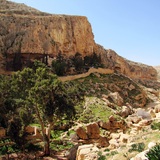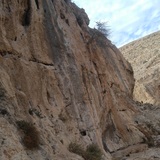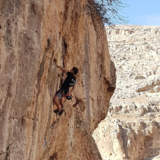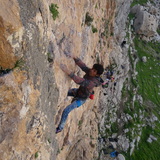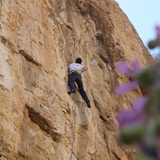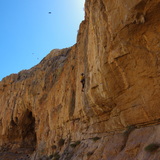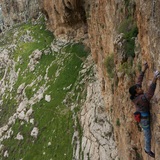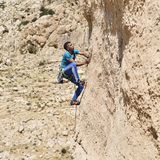Ein Fara is considered one of the best sport climbing sites in the Middle East, both for the quality and the quantity of the climbing and for the spectacular location. Ein Fara, known as “Ein Prat” by the Israelis, was first developed as a climbing site in the 1980s when some Israeli climbers opened the first mixed routes (trad/ sport). In the 1990s and 2000s sport climbing development increased and many new, beautiful routes were equipped. Israeli climbing activity in the West Bank was made possible by the military occupation of the West Bank that began in 1967 and the rapid expansion of Israel's colonization of Palestinian land.Today, the potential for climbing development of the valley is still huge, both for rope climbing and bouldering. Unfortunately, the "Israeli National Park Authority," whose authority in this area is illegitimate by international law, has banned the development of any additional climbing outside the signposted areas.
Access to the climbing area is a sensitive issue: There are three ways to enter the climbing area and, like many things in the West Bank, how you can access it depends on your ID and ethno-religious background. Once you reach the gate of the Anatot settlement, access to West Bank Palestinians and green-plated Palestinian cars is forbidden. Foreigners, Israelis and Jerusalemites are allowed to enter the settlement in yellow-plated Israeli cars. Palestinians, therefore, have two options: drive around the settlement on an unmarked dirt road (as described on the Access page) or park outside the gates of the Anatot settlement and hike down for about 45 minutes to the climbing area.
Many internationals and Palestinians opt for (or are forced to choose) the longer hike into the valley to avoid paying the 30 NIS fee charged by the Israeli Parks Authority and to not financially support the Israeli occupation of Palestinian land. Furthermore, the hike offers spectacular views of the wadi and surrounding walls.
All in all, there are more than 130 routes in Ein Fara equally distributed over two areas: the Northern Cliff and the Southern Cliff. Unfortunately a large number of existing climbs have been closed by the Israeli National Parks Authority. In the past, other developed sectors even had their bolts chopped! If you are caught climbing in any of the closed sectors, expect to pay a fine of 300 NIS or more.
